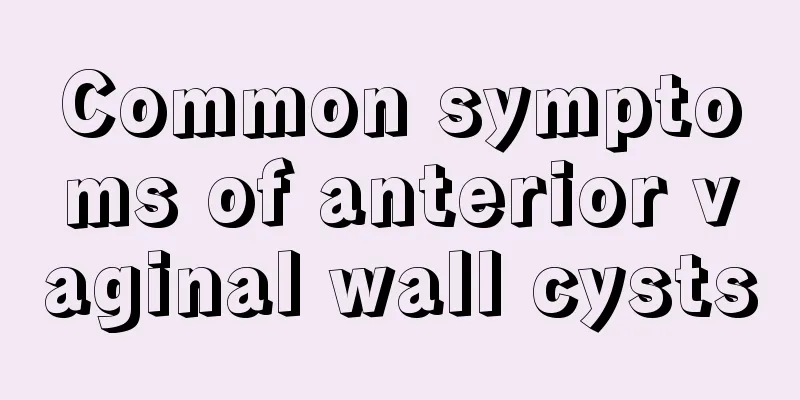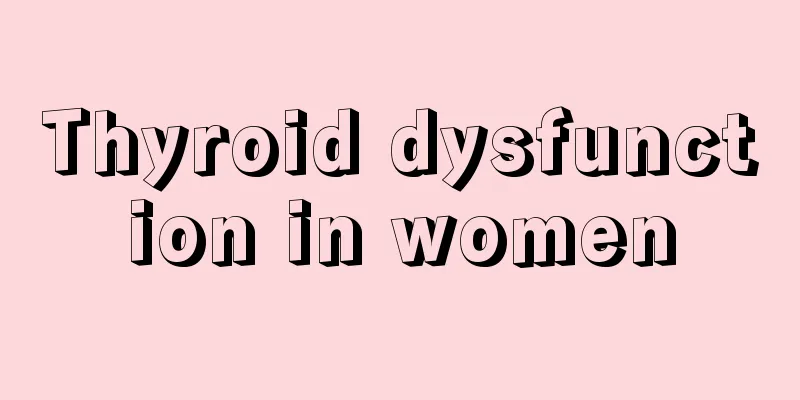Common symptoms of anterior vaginal wall cysts

|
Here are some common symptoms of anterior vaginal wall cysts. As society develops, the types of diseases are also increasing. Although people's health awareness has begun to rise to a certain level, sometimes they can't help but ignore the details of life due to carelessness. The incidence of anterior vaginal wall cysts is increasing. Therefore, the following introduces the common symptoms of anterior vaginal wall cysts to raise everyone's vigilance. Symptom 1. Increased abdominal circumference and abdominal swelling: The patient will feel discomfort in the lower abdomen and feel that the waist is getting thicker. Lower abdominal discomfort is the initial symptom before the patient feels a lower abdominal mass. Due to the weight of the tumor itself and the influence of intestinal peristalsis and changes in body position, the tumor moves in the pelvic cavity, involving its pedicle and pelvic infundibulum ligament, causing the patient to have a feeling of distension and heaviness in the lower abdomen or iliac fossa. Symptom 2: Abdominal pain: It often causes abdominal pain, leg pain, and pain, often causing patients to seek emergency treatment. Usually, huge ovarian tumors can cause dyspnea and palpitations due to compression of the diaphragm. Ovarian tumors combined with a large amount of ascites can also cause ovarian cysts blocking the birth canal and cause such symptoms. However, the dyspnea of some patients with ovarian tumors is caused by unilateral or bilateral pleural effusion. If the tumor has no complications, there is very little pain. Symptom 3: Menstrual disorders: Generally, ovarian cysts, even bilateral ovarian cysts, do not cause menstrual disorders because they do not destroy all normal ovarian tissues. Some uterine bleeding is not endocrine in nature. It may be caused by ovarian tumors that change the pelvic blood vessel distribution, causing endometrial congestion; or it may be caused by ovarian malignant tumors directly metastasizing to the endometrium. Menstrual disorders caused by endocrine tumors are often combined with other secretory influences. It is the most common benign vaginal tumor. There are no glands in the normal vagina, but isolated aberrant crypts can occasionally be found, which form retention cysts containing fluid. It is not a neoplastic or proliferative tumor. Generally, the cyst epithelium originates from the Müllerian duct, mesonephric duct and urogenital sinus during the embryonic period. Ovarian coronal duct cysts originate from the events of the medullary duct. Vaginal cysts are divided into two categories: epithelial cysts and embryonic relic cysts. Epithelial-containing cysts are caused by damage to the vaginal mucosa during childbirth, or the vaginal mucosa is rolled into the deep layer of the vagina during vaginal suture. After the wound heals, the mucosa continues to proliferate and desquamate, and then liquefies to form a cyst. It is usually asymptomatic and is often discovered during examination. Embryonic relic cysts are also called mesonephric duct cysts. If the mesonephric duct next to the vagina is blocked, secretions may accumulate and form cysts. They can be seen on the side wall or the anterior wall of the lower part of the vagina, in clusters or multiples, the size of grapes or ping-pong balls, with thin cyst walls and single-chambered. Generally, no treatment is required if there are no symptoms. However, if the tumor is large or infected, it can be removed. This is a minor operation that can usually be completed in one day. The patient will need to stay in the hospital for 1-2 days for observation, but he or she cannot have sexual intercourse within one month after the operation. According to survey data, the incidence of anterior vaginal wall cysts increases at a rate of 1.83% per year, and is most common in women aged 20-50. The cause of anterior vaginal wall cysts is not yet very clear. Its onset may be related to age, fertility, mental factors and environment. The common symptoms of anterior vaginal wall cysts that we have learned above can help improve prevention and vigilance in daily life. |
<<: Causes of elevated human chorionic gonadotropin
>>: Pre-pregnancy diet recipes
Recommend
Symptoms of external hemorrhoids in women
There are three main types of external hemorrhoid...
Can I eat dried fruits during confinement?
The purpose of confinement for new mothers is ver...
How to cure trichomoniasis vaginitis
Key reminder: Candidal vaginitis is a common gyne...
How to train chest muscles
A woman with plump breasts is a sign of sexiness,...
What is the TCM treatment for ovarian cysts?
Ovarian cyst is a gynecological disease that mode...
Women have difficulty urinating and need to exert force
As for urinary incontinence, it mainly refers to ...
Pain in the middle of my back after giving birth
Symptoms of back pain in women after childbirth a...
Reasons for right eye twitching in pregnant women
Eyelid twitching is a very common phenomenon in n...
Should I stop my baby from sucking his fingers when he is three months old? Why do babies like to eat their fingers?
Newborn babies like to suck their fingers, and so...
Daily changes in body temperature
The ovulation period is a very critical moment. M...
I was diagnosed with cancer at the age of 25, but I didn't take it seriously because I had symptoms two years ago! These "words" in the medical examination report are dangerous!
Many people schedule a physical examination for t...
It turns out that these are the causes of obesity!
Every day, we are immersed in the ideological str...
There are several types of pictures of Sheung Wan
Some female friends want to use an IUD as a contr...
What medicine can make menstruation come?
Sometimes menstruation can indeed cause a lot of ...
Benefits of acupuncture for women to lose weight
Acupuncture has many benefits for women to lose w...









